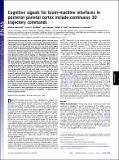Cognitive signals for brain–machine interfaces in posterior parietal cortex include continuous 3D trajectory commands
Author(s)
Hauschild, Markus; Mulliken, Grant Haverstock; Fineman, Igor; Loeb, Gerald E.; Andersen, Richard A.
DownloadHauschild-2012-Cognitive signals for brain-machine interfaces.pdf (2.433Mb)
PUBLISHER_POLICY
Publisher Policy
Article is made available in accordance with the publisher's policy and may be subject to US copyright law. Please refer to the publisher's site for terms of use.
Terms of use
Metadata
Show full item recordAbstract
Cortical neural prosthetics extract command signals from the brain with the goal to restore function in paralyzed or amputated patients. Continuous control signals can be extracted from the motor cortical areas, whereas neural activity from posterior parietal cortex (PPC) can be used to decode cognitive variables related to the goals of movement. Because typical activities of daily living comprise both continuous control tasks such as reaching, and tasks benefiting from discrete control such as typing on a keyboard, availability of both signals simultaneously would promise significant increases in performance and versatility. Here, we show that PPC can provide 3D hand trajectory information under natural conditions that would be encountered for prosthetic applications, thus allowing simultaneous extraction of continuous and discrete signals without requiring multisite surgical implants. We found that limb movements can be decoded robustly and with high accuracy from a small population of neural units under free gaze in a complex 3D point-to-point reaching task. Both animals’ brain-control performance improved rapidly with practice, resulting in faster target acquisition and increasing accuracy. These findings disprove the notion that the motor cortical areas are the only candidate areas for continuous prosthetic command signals and, rather, suggests that PPC can provide equally useful trajectory signals in addition to discrete, cognitive variables. Hybrid use of continuous and discrete signals from PPC may enable a new generation of neural prostheses providing superior performance and additional flexibility in addressing individual patient needs.
Date issued
2012-10Department
Massachusetts Institute of Technology. Department of Brain and Cognitive Sciences; McGovern Institute for Brain Research at MITJournal
Proceedings of the National Academy of Sciences of the United States of America
Publisher
National Academy of Sciences (U.S.)
Citation
Hauschild, M. et al. “Cognitive Signals for Brain-machine Interfaces in Posterior Parietal Cortex Include Continuous 3D Trajectory Commands.” Proceedings of the National Academy of Sciences 109.42 (2012): 17075–17080. ©2013 National Academy of Sciences
Version: Final published version
ISSN
0027-8424
1091-6490